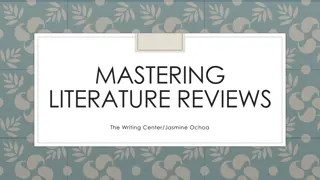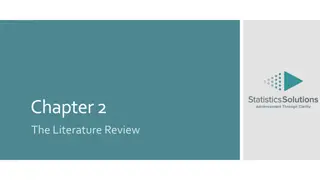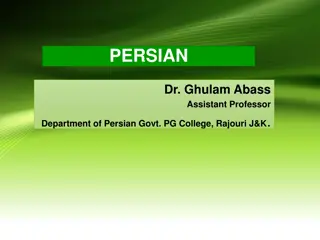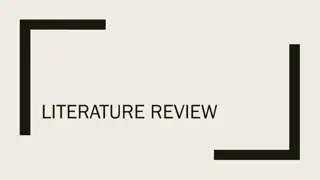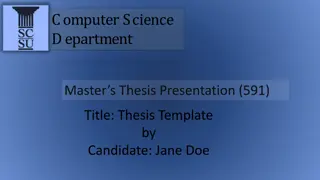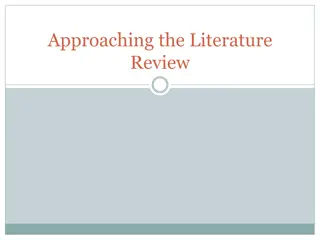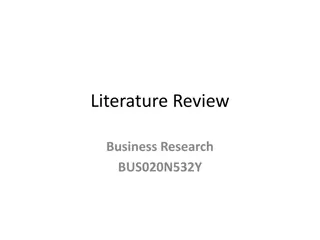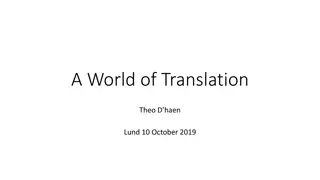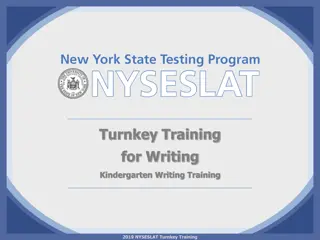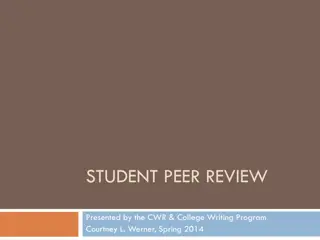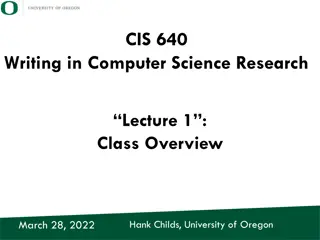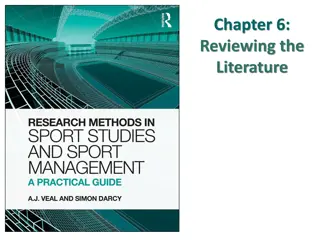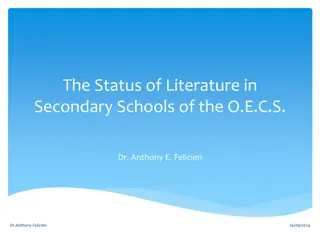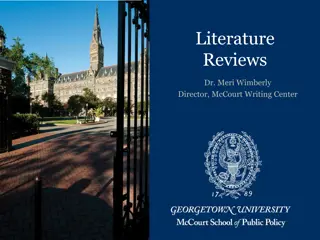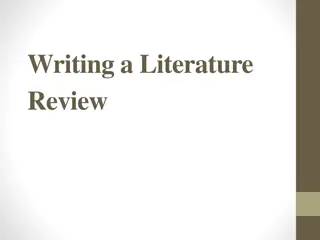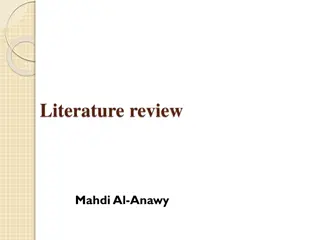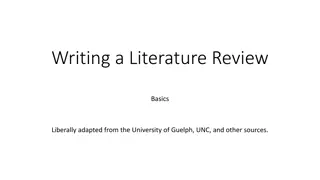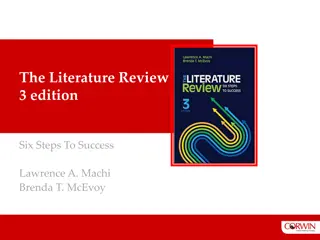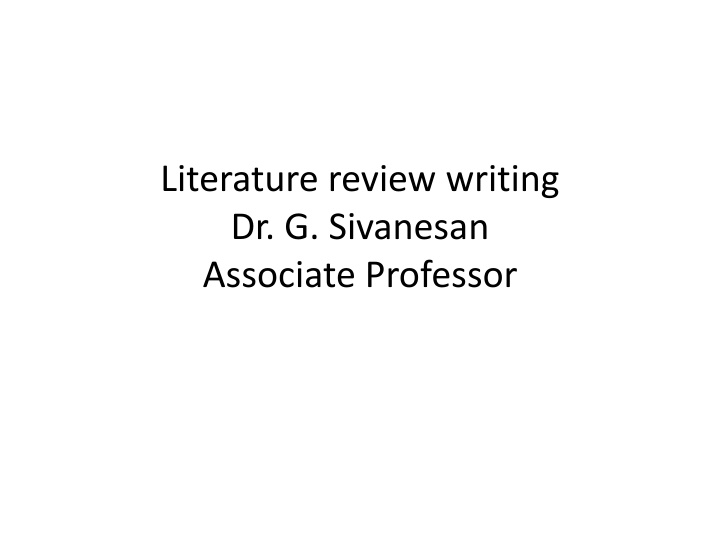
Importance of Literature Reviews in Management Research
Explore the significance of literature reviews in management research, uncovering how they help identify research gaps, contextualize findings, and integrate ideas across disciplines for optimal implications in academia and practice.
Download Presentation

Please find below an Image/Link to download the presentation.
The content on the website is provided AS IS for your information and personal use only. It may not be sold, licensed, or shared on other websites without obtaining consent from the author. If you encounter any issues during the download, it is possible that the publisher has removed the file from their server.
You are allowed to download the files provided on this website for personal or commercial use, subject to the condition that they are used lawfully. All files are the property of their respective owners.
The content on the website is provided AS IS for your information and personal use only. It may not be sold, licensed, or shared on other websites without obtaining consent from the author.
E N D
Presentation Transcript
Literature review writing Dr. G. Sivanesan Associate Professor
Introduction A literature review is a summary of a set of related research papers. It selects information from the papers, and organizes and integrates it into a logical justification for the author s research. Literature reviews are typically researchers who survey previous studies in order to identify research gaps and to place their own work in the context of previous findings. written by
Functions - Literature review can serve (1) To distinguish what has been done from what needs to be done. (2) To identify important variables relevant to the topic. (3) To synthesize earlier results and ideas, and gain a new perspective. (4) To rationalize the significance of the problem. (5) To identify the main methodologies and research techniques that have been used. (6) To place the research in context with state-of-art developments, and so on.
Why Undertake a Literature Review? The most striking feature of management research is an overwhelming consensus on the heterogeneity prevalent in ontological paradigmatic approaches. It is fragmented and characterized by ragged discipline boundaries methodologies from associated domains. This inherent heterogeneity tremendous debate at academic conferences and empirical contradictions in literature. Furthermore, management research is considered an applied domain that articulates a problem and often seeks clarity on solution sets for optimal performance. and epistemological utilizing knowledge and can result in
For any research to sustain in the domain of management, it must provide a direct address to a question what are the implications of this research for management? The research foci, problem statement, the propositions and hypotheses framed, results drawn, knowledge produced, and finally disseminated need a context for application. The very applied nature of research also places a unique demand on scholars to adopt a multidisciplinary approach to problem statements. The twin forces of heterogeneity and applicability of management research make it imperative for scholars to produce integrating ideas and bring together a cache of extant work/literature on related problems traversing (through or travel acress) discipline boundaries. This integration of ideas, problems, and literature would help scholars to better understand problems and results gleaned from varied sources to propose optimal implications of research for academia and practitioners alike.
Given this a typical nature of management research, there exist three major reasons or scenarios for scholars to conduct a review of literature. In the first scenario, scholars might undertake a review of extant work as an end goal to ascertain the quantum of work done in a particular area. The literature review could translate as an end in itself for the sole purpose of evaluating a domain of knowledge critically. The outcome of this analysis would help scholars to take stock of the work already done, identify the trends and patterns in research, the gaps and contradictions (if any), and finally put forth a proposal for further researchable dimensions.
In the second scenario, scholars undertake a literature review as a preliminary step in the completion of a larger research, that is, a doctoral dissertation. The primary purpose of the review is providing a sound rationale for the formulation of research objectives, questions, hypotheses. The review not only summarizes the nature of extant work on a particular theme but also sheds light on plausible (reasonable) research gaps germane to the research interest cited. propositions, and
The final scenario in which a scholar conducts a literature review is at the end of the research. The purpose of this review is to revisit the literature reviewed earlier to cull out the research gaps and the objectives of research (i.e., the second scenario) in the light of empirical results derived. This recourse helps the scholar to understand the concurrences or dissensions (dis-agreement) of results drawn with the literature reviewed earlier, address of research gaps within the scope of study and most importantly contribution of the research to the world of theory.
Types of Literature Reviews Systematic Literature Reviews Integrative Literature Reviews Narrative Literature Reviews
Systematic Literature Reviews Systematic reviews as an exhaustive search and presentation of literature (both published and unpublished) with details of the reviewer s decisions, procedures used, and conclusions drawn. They differentiate it from traditional literature reviews susceptible researcher bias. (liable) to
Roadmap - Systematic Literature Review a.Planning for the review: At the onset of review, a panel of experts come together to scope the research, clarify the problems and objectives and set the limits for the search of appropriate literature. These deliberations are captured in a formal document called the research protocol. As management research is interdisciplinary with the boundary lines between disciplines rather fuzzy, problems once defined may change. But all changes made need a recording in the review protocol in order to avoid researcher bias
SLR b. Conducting a systematic review The implementation of a systematic review begins with identification of inclusion and exclusion criteria and the use of keywords for searching papers/articles, etc. are an offshoot from the first phase, that is, planning. Systematic reviews need to provide all details of their search protocol for transparency and accuracy of results drawn. The second step undertaken in the implementation of such reviews is the selection of articles/papers (both published and unpublished). literature sources. The
In the beginning of review, it is generally advisable to include all relevant articles, papers, etc. that resound with the research problem identified. The number of sources included and excluded at each stage of selection need proper record and audit trails. The third stage in the conduct of review is termed as quality assessment. As management research is more amorphous than natural sciences, assessing the quality of a paper often poses a problem. Hence researchers often rely on the rating and ranking of journals for decisions on selection. These inherent problems make the next step even more crucial, that is, data extraction.
Data extraction contains the general details of a paper (i.e., title, author, publication) and notes on emergent themes, methodologies used, and conclusions drawn. The extraction process forms the base of documentation and analysis in any systematic review. The fifth step in the conduct of a systematic review is termed as research synthesis. Synthesis is broadly used to describe the summarizing, integrating, and cumulating the findings of different questions and themes. journal, year of studies on research
Major steps involved in conducting a systematic review identification of literature sources; selection of literature; assessing quality; data extraction; and research synthesis.
SLR c. Reporting and dissemination The efficacy of any systematic review is dependent on the synthesis of research presented. The first step entails descriptive analysis which reports simple forms of data extractions to questions such as who are the authors? Where are the major contributions to research from? What is the age profile of the articles? etc. The second step termed as thematic analysis is more important as it helps a reader understand the themes on which the articles converge and spectrum of work that has been done. Thematic analysis basically researchers on the quantum of work already done on any problem worthy of research and more importantly areas which have been neglected, sufficiently researched though with contradictory findings. Hence systematic reviews very often in their conclusions provide directions for further research. provides yardsticks to under researched or
Systematic reviews have provided support to meta-analytic works which have enriched understanding of researchers on their topic of interest with precision and scientific rigor. Meta- analysis is an alternate form of research synthesis in systematic reviews using the data pooled from individual studies for greater statistical analysis and reports on effect size. Though systematic reviews are of immense importance to a field of knowledge, there are certain limitations of this review process. Firstly, these reviews are difficult to undertake in disciplines such as management where the boundary lines between disciplines are fluid owing to the multidisciplinary nature of research problems. Secondly, these reviews often are vulnerable to the hegemony of the technical aspects of conducting a review in comparison to the analytical interpretations drawn. Finally, systematic reviews provide much greater impact in pure sciences with positivist origins and quantitative studies such as medicine
Integrative Literature Reviews Within management research few studies address a research problem in a similar manner drawing the same conclusions. Hence, authors are concerned with more inductive and flexible approaches to the presentation of extant work in a domain. Integrative literature reviews provide a flexible yet scientific gateway to conducting and reporting literature reviews in varied areas of management. The purpose of these reviews is to identify themes of research in extant work and propose fresh frameworks and perspectives for further research address.
(i) Organizing an integrative literature review The organization of such reviews involve a two-step process as outlined, namely conceptualizing the literature and describing how the review was conducted. The conceptualization of the review is important for deciding the scope of the problem and the inclusion and exclusion criteria employed while selection relevant extant literature with two guidelines for conceptualization. The first of these pertain to the use of a guiding theory to conceptualize the problem and arrange the literature gleaned. The second guideline helps authors make use of competing models to arrange literature and cull out themes for further analysis.
(ii) Writing an integrative literature review The writing of integrative reviews presents a critical analysis of literature reviewed and synthesizing new knowledge on a topic. A critical analysis of literature often requires authors to deconstruct a topic into elements such as its history, publication details, arrangements of ideas, research methods used, and conclusions drawn. Careful analysis often paves the path for a critique of extant work where authors make note of the key contributions of extant work to a field of interest and the same time endeavor to point out the omissions, inaccuracies, and other problematic aspects of the literature studied.
With the completion of critical analysis, authors now armed with their intimate knowledge about a certain area of research also bear the onus of presenting a synthesis of ideas for further address. Synthesis of literature is not a mere data dump but the use of a critical analysis to generate (a) a research agenda, (b) a taxonomy or conceptual constructs, (c) alternative models for further research, and (d) metatheory involving elaboration of existing theory/theories across domains. classification of
Narrative Literature Reviews The third and final categorization of literature reviews, that is, narrative literature reviews differ from systematic and integrative reviews on the continuum of flexibility. They constitute the most flexible of the three literature reviews with a basic purpose of aiding understanding on a topic of research. The reviews are less focused in their scope, may cover wide ranging topics, and finally employ loosely defined criteria for selection and exclusion of studies. These reviews are ideally suited for inductive research where the researcher may redefine the very scope of research on the collection and analysis of data. Thus, such reviews afford inductive researchers greater fluidity to modify the boundaries of the subject of their study as they go along with the research.
Methodology - SLR SLRs identify the relevant literature to a phenomenon by implementing prescribed methodological approaches and processes. It should be noted that SLRs differ from traditional narrative literature reviews which are generally selective of the literature they include, according to the preferences or availability of the author. Additionally, they tend to be descriptive rather than scientific. SLRs are guided by a predetermined review protocol and include evidence which is fit for the purpose. They must be exclusive, algorithmic and aggregative. The review should be easily replicated by anyone who follows the protocol, producing the same results each time.
SLR - Three-stage review process Stage one: planning the review. Stage two: conducting the review. Stage three: reporting and dissemination.
Stage one: planning the review Prior to commencing the review process, a panel with expertise in servant consulted to provide a robust overview of the phenomenon and recommend potential areas for research. They were able to advise on the comprehensive review protocol development. The protocol was also guided by a scoping study and a thorough narrative literature review. leadership was
Review questions RQ1. What are the themes present within the Green HRM literature? RQ2. What are the skills of Green HRM? RQ3. Where are the gaps in the research of Green HRM? Review criteria Selection criteria are necessary to filter results and evaluate the relevant research and information to be included in an SLR
Stage two: conducting the review As this study was protocol driven, it used the hand and electronic searching of databases. This study used widespread and generic Web-based searches to conduct the review. This review primarily used Google Scholar as a tool to identify databases. This made it clear which databases prominently featured Green HRM, narrowing the overall search. The SLR then used the following academically recognised and accepted databases to search for information: Emerald Insight , SAGE Publications, Springer link, Wiley Online, Taylor and Francis and Web of Science. These databases have been identified as suitable for SLRs within previous scholarly work. Within the aforementioned databases, relevant search strings were developed to identify data relevant to the research
Distribution of Articles The present study has reviewed 70 studies from various databases. Figure 2 shows that five journals accounted for about 40 per cent of the publications. The most frequent sources of publications were the Journal of Cleaner Production (10) followed by The International Journal of Human Resource Management (7), Industrial and Commercial Training (5), Journal of Business Ethics (3), German Journal of Management (3) and others. Human Resource
Years of publication This review of the literature began with publications for 2007, approximately the time at which green/environmental perspective emerged in the context of HRM. However, during the initial period of conception of Green HRM, the number of publications was very few (between 2007 and 2015) as the concept of Green HRM was new and the industry was fascinated with electronic HRM and the use of technology in HRM. In the recent years, due to organizations are putting more of an emphasis on environmental management, and the concept of Green HRM was given its due importance. Research attention has increased from 2016 and remains in a relatively positive trend. Many conceptual and empirical studies have been done to fine tune the Green HRM philosophy, and there has been widespread implementation of Green HRM in the industry. The continuous focus on this topic could be the result of the persistent attention given to Green HRM, which has been considered a popular academic area internationally since 2016. growing environmental concerns,


